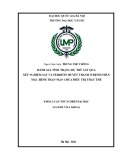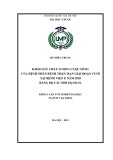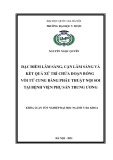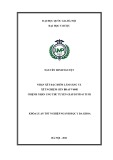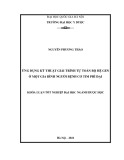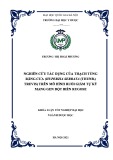
Implementation
Science
Bonetti et al. Implementation Science 2010, 5:25
http://www.implementationscience.com/content/5/1/25
Open Access
RESEARCH ARTICLE
BioMed Central
© 2010 Bonetti et al; licensee BioMed Central Ltd. This is an Open Access article distributed under the terms of the Creative Commons
Attribution License (http://creativecommons.org/licenses/by/2.0), which permits unrestricted use, distribution, and reproduction in
any medium, provided the original work is properly cited.
Research article
Applying psychological theories to
evidence-based clinical practice: identifying
factors predictive of placing preventive fissure
sealants
Debbie Bonetti*
1
, Marie Johnston
2
, Jan E Clarkson
1
, Jeremy Grimshaw
3
, Nigel B Pitts
1
, Martin Eccles
4
, Nick Steen
4
,
Ruth Thomas
5
, Graeme Maclennan
5
, Liz Glidewell
6
and Anne Walker
5
Abstract
Background: Psychological models are used to understand and predict behaviour in a wide range of settings, but
have not been consistently applied to health professional behaviours, and the contribution of differing theories is not
clear. This study explored the usefulness of a range of models to predict an evidence-based behaviour -- the placing of
fissure sealants.
Methods: Measures were collected by postal questionnaire from a random sample of general dental practitioners
(GDPs) in Scotland. Outcomes were behavioural simulation (scenario decision-making), and behavioural intention.
Predictor variables were from the Theory of Planned Behaviour (TPB), Social Cognitive Theory (SCT), Common Sense
Self-regulation Model (CS-SRM), Operant Learning Theory (OLT), Implementation Intention (II), Stage Model, and
knowledge (a non-theoretical construct). Multiple regression analysis was used to examine the predictive value of each
theoretical model individually. Significant constructs from all theories were then entered into a 'cross theory' stepwise
regression analysis to investigate their combined predictive value
Results: Behavioural simulation - theory level variance explained was: TPB 31%; SCT 29%; II 7%; OLT 30%. Neither CS-
SRM nor stage explained significant variance. In the cross theory analysis, habit (OLT), timeline acute (CS-SRM), and
outcome expectancy (SCT) entered the equation, together explaining 38% of the variance. Behavioural intention -
theory level variance explained was: TPB 30%; SCT 24%; OLT 58%, CS-SRM 27%. GDPs in the action stage had
significantly higher intention to place fissure sealants. In the cross theory analysis, habit (OLT) and attitude (TPB)
entered the equation, together explaining 68% of the variance in intention.
Summary: The study provides evidence that psychological models can be useful in understanding and predicting
clinical behaviour. Taking a theory-based approach enables the creation of a replicable methodology for identifying
factors that may predict clinical behaviour and so provide possible targets for knowledge translation interventions.
Results suggest that more evidence-based behaviour may be achieved by influencing beliefs about the positive
outcomes of placing fissure sealants and building a habit of placing them as part of patient management. However a
number of conceptual and methodological challenges remain.
Background
Dental decay is the most common chronic disease of
childhood. In addition to the pain involved, there can be
an impact on the children's ability to eat, sleep, and learn,
as well as on their emotional well-being and self esteem
[1-4]. There is evidence that the prevalence of dental car-
ies in children in Scotland is a significant clinical prob-
lem, and that most children are at risk of developing the
disease [5]. There is considerable evidence regarding the
effectiveness of preventive treatments, and in particular,
* Correspondence: d.bonetti@cpse.dundee.ac.uk
1 Dental Health Services Research Unit, University of Dundee, Mackenzie
Building, Kirsty Semple Way, Dundee DD2 4BF, UK
Full list of author information is available at the end of the article

Bonetti et al. Implementation Science 2010, 5:25
http://www.implementationscience.com/content/5/1/25
Page 2 of 14
preventive fissure sealants (PFS). Fissures, particularly
deep fissures in the biting surface of teeth are very diffi-
cult to clean, and so tend to accumulate debris that leads
to the development of caries. The evidence is that sealing
fissures in healthy teeth with a plastic coating makes the
development of caries much less likely. A Cochrane sys-
tematic review [6] found that PFS, relative to no treat-
ment, reduced decay by 86% after 12 months. PFS
treatment for children at risk of caries is supported by
The American Academy of Paediatric Dentistry, The
European Academy of Paediatric Dentistry, and The Brit-
ish Society of Paediatric Dentistry [7-9]. Despite this sup-
port, and that PFS application is inexpensive, easy to do,
and long-lasting, fewer than 20% of 11 year olds living in
Scotland had their first molars sealed at the time of this
study [10].
Implementation research, the scientific study of meth-
ods to promote the uptake of research findings, includes
the development and testing of interventions that enable
healthcare professionals to use research findings more
effectively [11-13]. However, currently there is little infor-
mation to guide the choice, or allow the optimisation of
the components of such complex interventions when
they are introduced into routine care settings [13,14].
Literature reviews suggest that the main problem in
this area may be a lack of understanding or description of
the mechanism by which these interventions are achiev-
ing their effect [15-17]. Since implementing guidelines
often require clinicians to change their behaviour, it may
be helpful to base implementation interventions on
explanatory models explicitly concerned with behaviour
change. Many psychological models explain behaviour in
terms of predictive beliefs that can be influenced, as well
as methods for measuring and influencing them. In
effect, they provide a means of focusing the design of an
intervention and include an explanation of how it will
work. Some evidence exists that support the application
of psychological theories to clinical behaviour, but this
evidence tends to be limited to one theory or one group
of models [e.g., [18,19].
This study, one part of a larger project [20-22], used a
number of psychological theories to explore factors asso-
ciated with the placing of PFS. Factors were drawn from
the Theory of Planned Behaviour (TPB) [23,24], Social
Cognitive Theory (SCT) [25,26], Implementation Inten-
tion (II) [27], Operant Learning Theory (OLT) [28]http://
www.bfskinner.org/BFSkinner/Home.html, Common
Sense Self-regulation Model (CS-SRM) [29,30], and an
adaptation of Stage Models [31,32]. These specific theo-
ries, described in detail elsewhere [20], were chosen
because they have all been rigorously evaluated in other
settings, they all explain behaviour in terms of factors
that are amenable to change, and they vary in their
emphasis.
At the time of this study, the placement of PFS in Scot-
land came under a general capitation fee, which meant
that there was no data available on the number of PFS
actually placed. This meant that it was not possible to
explicitly assess this behaviour (see Additional File 1).
Two proxy outcomes were included in this analysis. One
outcome measure (behavioural simulation) used deci-
sions made in response to written clinical scenarios -- a
common means of testing clinical decision-making in
medical and dental education. There is also some evi-
dence that scenario-based decision-making is signifi-
cantly related to actual behaviour [22]. The second
outcome was a theoretically derived measure, behav-
ioural intention, because there is also evidence support-
ing intention as a consistent predictor of subsequent
behaviour [16,18,23].
The aim of this study was to identify factors, derived
from these psychological models, associated with the
decision to place a PFS in six to sixteen year old patients.
Methods
Design and participants
The design was a predictive study with theoretical vari-
ables and outcomes (behavioural simulation and inten-
tion) measured by a single postal questionnaire.
A random sample of 450 general dental practitioners
(GDPs) from Scotland were selected from the Scottish
Dental Practice Board list by a statistician using a list of
random sampling numbers. Eligible participants were
GDPs in Scotland who had not been randomly selected to
be invited to participate in a previous survey [21] that was
part of the larger project [20].
Predictor measures
Theoretically derived measures were developed following
the operationalisation protocols of Ajzen [23,24], Ban-
dura [25,26], Armitage and Conner [33], M Conner and
Sparks [34], Moss-Morris [30], Francis et al. [35], Black-
man [28] and Weinstein [31,32]. The questions were
informed by a preliminary, qualitative study with 29
GDPs in Scotland who took part in a semi-structured
interview of up to 40 minutes as recommended for the
TPB. The interviews used standard elicitation methods
and covered the views and experiences about the use of
PFS in the management of caries in six to sixteen year old
patients. Responses were used, in conjunction with the
operationalisation literature (above), to create the ques-
tions measuring theoretical constructs. Five knowledge
questions were developed by the study team based on
areas of good evidence around the use of PFS. Table 1
provides a summary of the predictor measures used in
this study (see also [20]); the instrument and its index are
available as Additional Files 2 and 3. Unless otherwise

Bonetti et al. Implementation Science 2010, 5:25
http://www.implementationscience.com/content/5/1/25
Page 3 of 14
Table 1: Summary of the predictive measures used in the PRIME study investigating beliefs associated with the placing of
preventive fissure sealants (PFS)
Theory of Planned Behaviour [23]
Variables (number of items) Example Item(s)
Behavioural intention (3) I intend to place FS as a primary part of managing caries in six to
sixteen year old patients.
Attitude
Direct (2); Indirecta (7) behavioural beliefs (bb) multiplied by 7 outcome
evaluations (oe). The score was the mean of the summed multiplicatives.)
D: In general, the possible harm caused by placing PFS is outweighed
by its benefits;
I: In general, placing a PFS effectively reduces caries risk x effectively
reducing caries risk is (un/important).
Subjective Normb
Indirect (3) normative beliefs (nb) multiplied by 3 motivation to comply
items (mtc). The score was the mean of the summed multiplicatives).
I feel under pressure from the Dental Practice Board to place PFS (nb)
x How motivated are you to do what the Dental Practice Board thinks
you should (mtc: very much/not at all).
Perceived Behavioural Control
Direct (5); Indirect/power (10)c
D: It is entirely up to me whether I place PFSs;
I: I find it difficult to decide in favour of placing a PFS if the patient is a
poor attender.
Social Cognitive Theory [25,26]
Risk Perception (6) It is highly likely that children with medium to high risk of caries will
be worse off if I do not place PFS.
Outcome Expectancies
Self (2 × 2), Behaviour (7 × 7). The score was the mean of the summed
multiplicatives.
S: If I place PFS, then I will think of myself as a caring dentist x Thinking
of myself as a caring dentist is (Un/Important).
B: See Attitude TPB
Self Efficacy
General: Generalized Self-Efficacy Scale (Schwarzer, 1992) (10: 4-point
scale, not at all true/exactly true); Specific (12)
General: I can always manage to solve difficult problems if I try hard
enough.
Specific: How confident are you that you can effectively place a PFS in
a six to sixteen yr old if the child has poor oral hygiene.
Implementation intentions [27]
Action planning (1) Currently, my standard method of managing caries does not primarily
include placing a PFS.
Operant conditioning [28]
Anticipated consequences (6) Mean If I routinely place PFS then on balance, my life will be easier in the
long run.
Evidence of habit (2) Mean When I see a patient, I automatically consider placing a PFS.
Experienced (rewarding and punishing) consequences (4): more likely to
PFS (score = 1); less likely (score = -1); unchanged/not sure/never
occurred (score = 0)). Scores were summed.
Think about the last time you decided to place a PFS in a six to sixteen
year old patient and felt pleased that you had done so. Do you think
the result of this episode has made you...
Self-regulation modeld [29,30]
Perceived identity (3) Caries is a condition with symptoms generally of an intense nature.
Perceived cause (5) Caries is caused by poor oral hygiene.
Perceived controllability (7) What the patient does can determine whether caries reverses or
progresses, What I do can determine whether the patient's caries
reverses.
Perceived duration (4) Caries is a condition which is likely to be permanent rather than
temporary.
Perceived consequences (4) Caries does not have much effect on a patient's life.
Coherence (2) I have a clear picture or understanding of caries.
Emotional response (4) Seeing patients with caries does not worry me.
Stage [31,32]

Bonetti et al. Implementation Science 2010, 5:25
http://www.implementationscience.com/content/5/1/25
Page 4 of 14
stated, all questions were rated on a seven-point scale
from 'strongly disagree' to 'strongly agree'.
Outcome measures
Behavioural simulation
Key elements that may influence GDPs' decisions to place
PFS were identified from the literature (including the
SIGN guideline 47 [5] recommendations), expert opinion
of the clinical members of the research team, and the ini-
tial interviews with 29 GDPs. These elements were cate-
gorized into: clinical elements (standard of oral hygiene,
clinically detectable caries, unrestored enamel lesions,
sugar consumption, number of restorations already pres-
ent, use of fluoride supplements (toothpaste, tablets),
time since last seen); dentist elements (responsiveness to
parental pressure, busy clinic, knowledge of patient/
patient's family); and patient elements (age, irregular/reg-
ular attenders, treatment phobia, parent' desire (does/
doesn't want PFS placed), social class, uncooperative). Six
clinical scenarios were constructed by randomly choosing
six to eight of these elements to describe a situation of
patients presenting in primary care. The scenarios were
piloted with six dentists and one dental hygienist.
Respondents were asked to decide whether they would
place a PFS (score = 1) or would not place a PFS (score =
0). Decisions in favour were summed to create a total
score out of a possible maximum of six. In all scenarios,
the decision to place a PFS would be following evidence-
based practice.
Behavioural intention
Three items assessed intention to place PFS: 'I aim to
place PFS as part of six to sixteen year old patient man-
agement';' I have in mind to place PFS when I see six to
sixteen yr olds'; 'I intend to place PFS as a primary part of
managing caries in six to sixteen year old patients'. The
mean score of the three responses were scaled so that
higher scores reflected stronger intention to place a PFS.
Procedure
The randomly selected dentists were sent an invitation
pack (letter of invitation, questionnaire consisting of psy-
chological and demographic measures and a consent
form to allow access to their fee claims data, as well as a
reply-paid envelope). Three postal reminders were sent
to non-responders at two, four, and six weeks after the
first mailing.
Sample size and statistical analysis
The target sample size of 200 was based on a recommen-
dation by Green [36] to have a minimum of 162 subjects
when undertaking multiple regression analysis with 14
predictor variables.
Data were analysed using SPSS Statistics 17.0 [37].
Missing data for each item were replaced with the indi-
vidual's mean over all the items of that measure, provid-
ing only two or less items from the measure were missing.
The internal consistency of the measures was tested using
Cronbach's alpha. If this was less than 0.6, then question-
naire items were removed from each measure to achieve
the highest Cronbach's alpha possible. For two question
constructs, a correlation coefficient of 0.25 was used as a
cut off. The relationship between predictive and outcome
variables were examined within the structure of each of
the theories, using Pearson correlations and ANOVA (for
the stage model categories).
Current stage of change. A single statement is ticked to indicate the
behavioural stage
Which of these sentences most characterises you at the moment?
Unmotivated (3): I have not yet thought about changing the number
of PFS I place.
Motivated (2): I have decided that I will place more/less PFS.
Action (2): I have already done something about increasing/
decreasing the number of PFS I place.
Other measures
Knowledge (5) (True/False/Not Sure) PFS are recommended for routine use with high-risk children.
Demographic gender, time qualified, number of other dentists in practice, trainer
status, hours per week, list size, if the practice employs hygienists.
aAll indirect measures consist of specific belief items identified in the preliminary study as salient to placing PFS.
bThese individuals and groups were identified in the preliminary study as influential in the decision to place a PFS
cAn indirect measure of perceived behavioural control usually would be the sum of a set of multiplicatives (control beliefs x power of each belief
to inhibit/enhance behaviour). However, the preliminary study demonstrated that it proved problematic to ask clinicians meaningful questions
which used the word 'control' as clinicians tended to describe themselves as having complete control over the final decision to perform the
behaviour. Support for measuring perceived behavioural control using only questions as to the ease or difficulty of performing the outcome
behaviour was derived from a metanalysis which suggested that perceived ease/difficulty items were sensitive predictors of behavioural
intention and behaviour [24].
d Illness representation measures were derived from the Revised Illness Perception Questionnaire [30]
Table 1: Summary of the predictive measures used in the PRIME study investigating beliefs associated with the placing of
preventive fissure sealants (PFS) (Continued)

Bonetti et al. Implementation Science 2010, 5:25
http://www.implementationscience.com/content/5/1/25
Page 5 of 14
Table 2: Descriptive statistics of the predictor measures.
Theoretical framework Constructs N Alpha Mean SD
Theory of Planned
Behaviour (TPB)
Attitude direct 2 0.57 5.64 0.99
Attitude indirect 7 0.76 29.94 6.62
Subjective Norm 3 0.70 14.88 7.22
Intention 3 0.79 4.90 1.24
PBC direct 5 0.61 4.53 0.96
PBC power 10 0.80 3.98 0.97
Social Cognitive Theory (SCT) Risk perception 6 0.60 4.84 0.79
Outcome expectancies 9 0.80 24.93 4.68
Self efficacy 10 0.82 4.55 0.89
Generalised self efficacy 10 0.87 3.05 0.38
Implementation Intention (II) Action Planning - - 5.15 1.59
Operant Learning Theory (OLT) Anticipated consequences 3 0.42 4.84 0.89
Evidence of habitual behaviour 3 0.86 4.37 1.61
Experienced consequences 4 0.25 0.37 0.86
Common Sense Self regulation
Model (CS-SRM)
Identity of condition 2 0.38 3.64 1.26
Timeline acute 2 0.46 5.50 1.12
Timeline cyclical 2 0.42 3.49 1.35
Control (by treatment) 3 0.46 5.89 0.92
Control (by patient) 3 0.61 5.60 1.11
Control (by doctor) 2 0.13 5.47 1.00
Cause a (past care) 1 - 2.67 1.49
Cause b (exposure to fluoride) 1 - 4.68 1.71
Cause c (chance or bad luck) 1 - 2.39 1.48
Cause d (Diet) 1 - 6.59 0.82
Cause e (oral hygiene) 1 - 6.28 1.21
Consequence 2 0.411 4.93 1.22
Emotional Response 4 0.652 3.58 1.11
Coherence 2 0.524 5.76 1.01
Stage Model Behavioural Stage*


